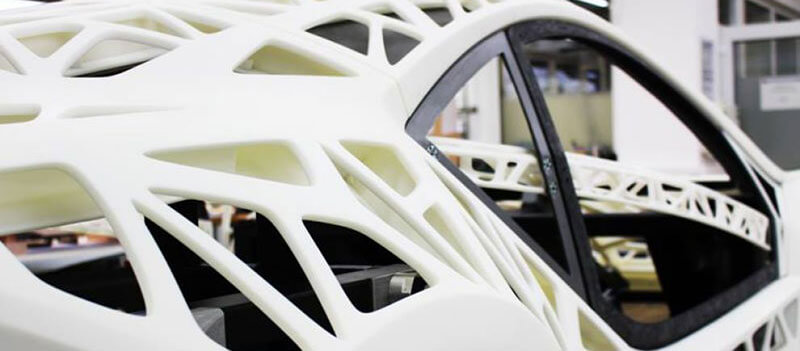Additive manufacturing, otherwise known as 3D printing, is beginning to make its mark on a wide range of industries, from medical device manufacturing to aerospace.
One of the biggest beneficiaries of additive, however, is the automotive industry, in which car manufacturers are using 3D printing to prototype components, create libraries of spare and customized parts and even create end-use parts for roadworthy vehicles.
To demonstrate how 3D printing can be used to great effect in the automotive industry, we’re going to look at five distinct ways that additive manufacturing is changing the world of cars.
1. 3D printed cars
We’ll start with what is clearly the most drastic application of additive manufacturing in the automotive industry: 3D printing an entire car. (Well, all of it except critical parts like the tires, steering system, brakes and engine.)
While 3D printing is generally suited to specific materials and applications, that hasn’t stopped adventurous companies like Arizona-based Local Motors from attempting to create an entire car body using additive manufacturing technologies.
Back in 2014, Local Motors introduced its first 3D printed electric car to the world. It was named “Strati” and could be 3D printed in less than a day using the giant BAAM (Big Area Additive Manufacturing) 3D printer developed by Cincinnati Incorporated and operated by Oak Ridge National Laboratory.
Not many companies have followed Local Motors’ lead in attempting to design a car whose entire body can be 3D printed, but the speed of manufacturing demonstrated by the Arizona company has given automakers food for thought.
2. Rapid prototyping of parts
Although many major 3D printer companies now sell their machines as production tools, additive manufacturing is still seen by many as a prototyping technology. Why? Well, it’s fast, only uses a small amount of material and allows for the creation of complex geometries.
Seeking to capitalize on those advantages, several automotive companies use additive manufacturing to prototype new components, often 3D printing a handful of iterations to see what works and what doesn’t.
In fact, the automotive industry is generally seen as one of the earliest adopters of 3D printing as a rapid prototyping tool, with major names like Ford and BMW picking up additive manufacturing systems back in the 1990s in order to develop concepts at the pre-manufacturing stage.
3. Reduced environmental impact
Another contemporary specialist in the production of 3D printed vehicles is California-based Divergent Technologies. Unlike Local Motors, however, Divergent isn’t attempting to 3D print an entire car.
Divergent founder Kevin Czinger established his company not just to create 3D printed vehicles, but to reshape the automotive product cycle. His philosophy centers around the use of local “microfactories” — instead of large production facilities — in which automakers can reduce both the cost and environmental impact of car production by 3D printing metal structural components for their cars.
“The time has come for a new model of decentralized car production that fosters pioneering car designs and lowers costs while alleviating environmental damage,” Czinger said last year.
Divergent’s signature vehicle, the Blade supercar, weighs just 630 kg (1,389 lb), which contributes to its incredible acceleration: the 3D printed car can go from 0–97 km/h (0–60 mph) in just 2.2 seconds.
4. On-demand replacements
One of the most important uses of additive manufacturing technology (across all industries) is its ability to quickly fabricate replacement parts for complex systems — either to update them or to fix them when they need repairing.
By 3D printing these replacement parts on demand rather than keeping a large inventory of spare parts, manufacturers can save huge amounts of money, since they only make parts as and when required and do not need to keep large warehouses for inventory.
The practice of 3D printing replacement parts on demand is becoming more and more commonplace within the automotive industry, as was recently demonstrated by Mercedes-Benz Trucks, which is now 3D printing replacement parts for its older vehicles using Selective Laser Melting (SLM) 3D printing systems.
Last year, Andreas Deuschle of Mercedes-Benz Trucks said his company’s 3D printed metal parts could “ensure the same functionality, reliability, durability and cost-effectiveness” as conventionally produced parts.
5. Formula 1 advancements
Additive manufacturing is playing a huge role in the development and maintenance of consumer vehicles, but it is also becoming more prominent in motorsports — including on the biggest stage of all: Formula 1.
British racing team McLaren, for example, uses 3D printing in several ways. At its headquarters in England, McLaren uses FDM and PolyJet 3D printers to create prototype parts from materials such as carbon fibre reinforced nylon and ABS, testing them for performance before reaching any decision on a finished part.
McLaren has even been known to use a 3D printer during races, keeping a Stratasys machine trackside to quickly fabricate small parts. A gimmick perhaps, but a sure sign that additive manufacturing is racing its way into the fast lane.
3ERP, an on-demand manufacturing specialist with experience in 3D printing and automotive prototyping, is well-placed to offer assistance on additive manufacturing automotive projects, as well as automotive prototyping via other technologies such as aluminum machining and injection molding.






